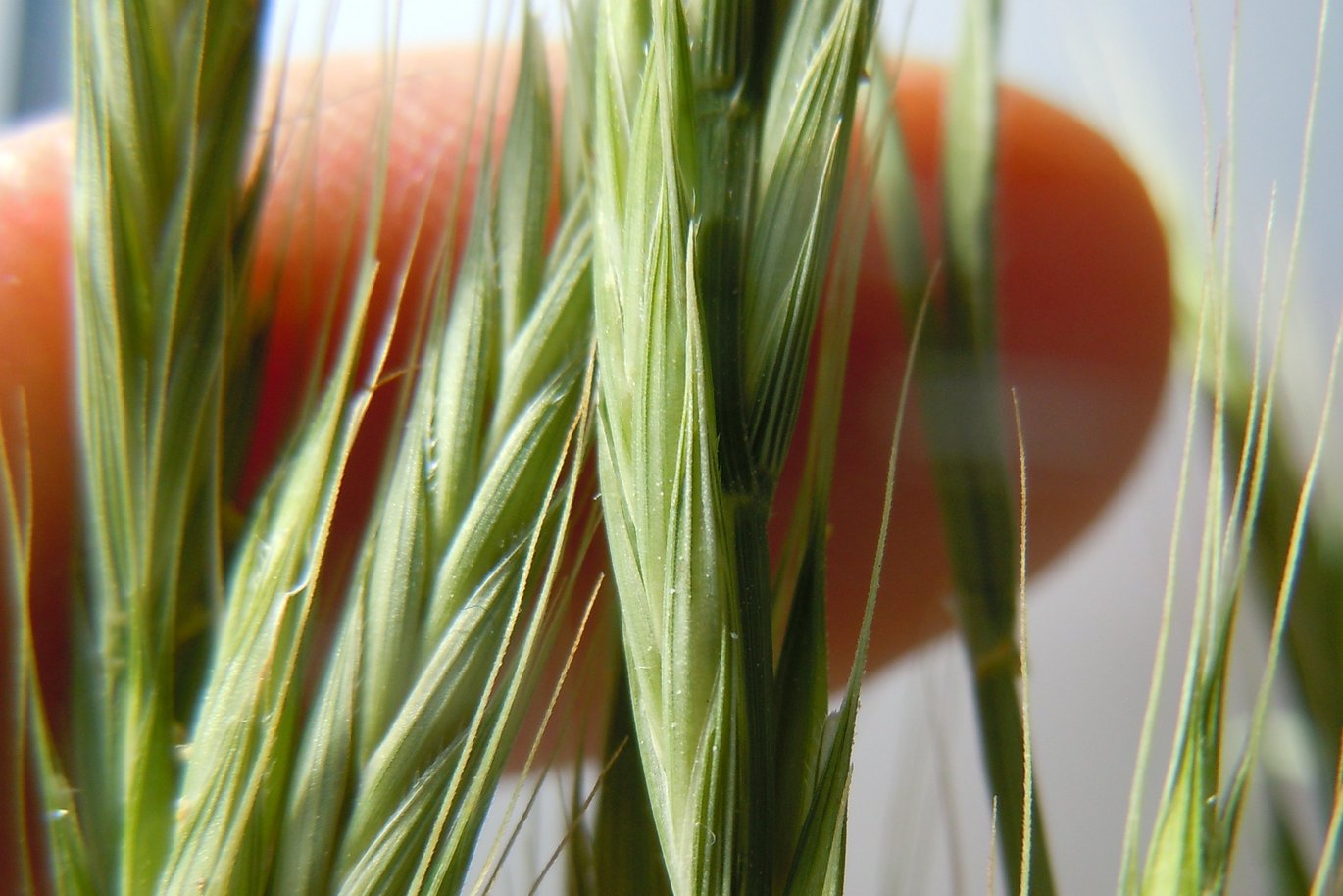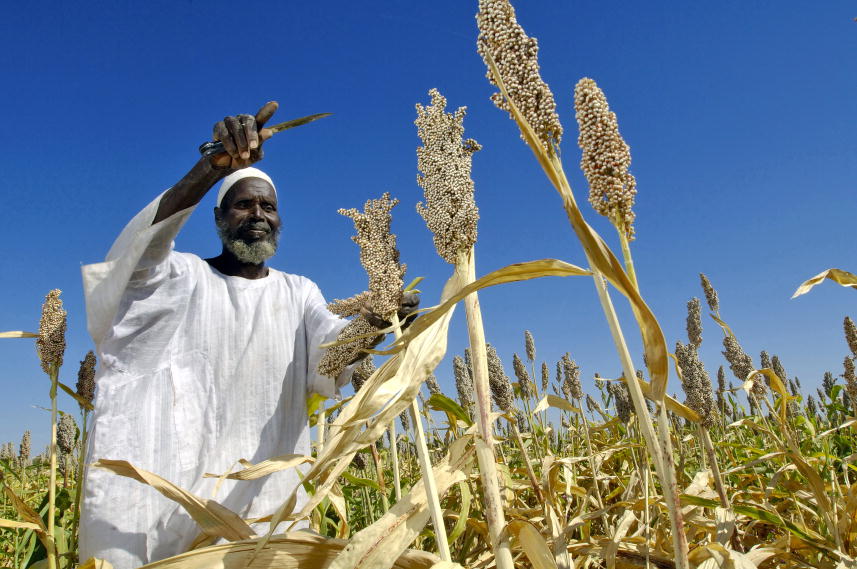An important but often overlooked step in the green transition: Danish research center maps crucial climate genes in crops
By mapping genes that enable crops to better withstand drought, heat or freezing temperatures, researchers at Aarhus University lay the foundation for a greener and more sustainable future.

Almost every morning Guillaume Ramstein walks through the university park in Aarhus on his way to work. At this time of the year the old oak trees teem with bright green colors and the grass is covered in dandelions and daisies.
When he takes a seat in front of his monitor, he’s ready to study the genes of plants. Not the plants in the beautiful park, but a little known grass called Brachypodium.
On his computer he looks through enormous amounts of data trying to find useful genes in the small plant. Genes that enable the plant to withstand longer periods of drought or higher temperatures.
The reason he’s studying this little known plant and not wheat, barley or corn which we all know from trips to the countryside, is that Brachypodium is kind of like mice in pharmacological research.
- We call Brachypodium the mouse of cereals, because it works as a model organism to test new things on. Like the mice used in the medical sector, it’s much easier to breed and genetically it’s pretty similar to crops like wheat or barley, Guillaume Ramstein explains.
- Because Brachypodium only has about 300 million letters in its DNA compared to 17 billion in wheat, it’s also much cheaper and easier to sequence and work with.
By mapping the useful genes that make these plants better suited for climate change and a more plant based future, Guillaume Ramstein and his colleagues are laying the foundation for both genetic modifications and traditional breeding.
The letters of the DNA
In the center of human, animal and plant cells there is a small core called the nucleus which contains our DNA.
Inside the nucleus the long two-stranded threads of DNA curl up and form the chromosomes. The threads are made up of nearly endless sequences of four small molecules, which we abbreviate A, C, G and T. People also call them the letters of the DNA.
It’s the order of these letters that determine the function of our genes. Usually genes consist of thousands of letters, but a single wrong letter in the sequence may lead to both good and bad outcomes.
Whenever cells divide they need to copy all the genetic information. This process of copying sometimes goes wrong resulting in incorrect letters in the genome. Usually the cell corrects these errors but not always.
The same thing happens when a new plant or animal is conceived. During the mixing of the genes of the mother and father errors or new combinations may occur. These random variations are the mechanism for evolution.
Small genetic deviation makes a huge difference
Brachypodium is not the only plant Guillaume Ramstein and his colleagues are studying. They also have a plant called Sorghum under their microscope.
Sorghum is the fifth most important cereal crop in the world in terms of production and harvested area. It’s a tropical plant used for grain and for feeding animals, originally in Africa and Asia, but also in North America and Southern Europe.
In Sorghum they found a very useful genetic mutation, he explains.
- We found a variant in a gene that does photosynthesis. Plants with an A instead of a G in this position seem to have a higher effectiveness when transforming sunlight into energy.
- This is important because the gene is similar in a lot of other crops. Our computer model suggests that the variation is also naturally present in species related to Sorghum such as maize and sugarcane.
Locating these small variations in the genome is laying the foundation for more targeted breeding. When the breeders know exactly which variations in the DNA to look for, it makes developing new crops adapted for a changing climate easier.
About the Center for Quantitative Genetics and Genomics
Together with 70 research colleagues at the Center for Quantitative Genetics and Genomics (QGG), Guillaume Ramstein is working to improve the way in which we breed animals and plants today.
With the help of large statistical models, researchers at QGG identify the genetic traits in animals and plants valuable to agriculture. For example, a valuable trait would be cows that produce less methane during digestion or produce more milk. Or a trait enabling a plant to better resist a certain type of pest.
With the knowledge produced by Guillaume Ramstein and his colleagues, the agricultural sector can more easily breed animals and plants that are more sustainable and better geared for the green transition.
More than 20 nationalities are employed at QGG working closely with industry and agriculture throughout the world.
A foundation for new genomic techniques
When Guillaume Ramstein and his colleagues at QGG find variations in crops they stop there – and there’s a reason for that, he explains.
- We publish our findings in academic journals and we collaborate with other research groups and the industry when they use our findings. Whether they use new genomic techniques like CRISPR or classical breeding.
Using new genomic techniques (NGTs) to edit crops is under strict regulation in the EU, but new legislation is on its way. Earlier this year the European Parliament voted to allow the use of NGTs in some cases. Moreover, scientists can already get a long way by introducing mutations by chemicals and other means, which are not under strict regulation under EU legislation.

As it is right now, NGTs are regulated by the same rules as GMO, but if the new legislation is passed in the European Council as well, it will allow for the use of NGTs in making genetic changes that could occur naturally in crops.
In other words it will enable the industry to use NGTs as a shortcut to getting the desirable traits in the crops. Traits that might take many generations of plants to achieve with traditional breeding methods.
And this is where Guillaume Ramsteins’ research comes in. Many of his discoveries are mutations occurring naturally in other types of plants – like the variation in the Sorghum plant – and if the legislation is passed, the industry will be able to legally induce those mutations in popular European crops.
New Genomic Techniques (NTGs)
Since the early 2000s genomic technology has developed at a very fast pace. This has resulted in a lot of new techniques for editing the genome of plants and animals.
Overall these techniques can be put into two categories:
- Technologies that transfer genes from other organisms into the plant.
- Technologies that edit directly in the genome of the plant.
In 2012 Jennifer Doudna and Emmanuelle Charpentier discovered that CRISPR, a bacterial immune system, could be reprogrammed to edit anywhere in the DNA of humans, animals and plants.
CRISPR is one of several techniques to edit DNA, but has been the cheapest and most successful so far. With the new EU-legislation on NGTs, the technology is going to be important for the agroindustry.
Other technologies, like mutagenesis by chemicals or radiation, also introduce mutations in plant genomes, but they are not regulated by EU legislation and will remain important for the industry.
People are very skeptical
In 2021, a company in Japan developed the first ever CRISPR-edited crop – a gene-edited tomato that contains high levels of an amino acid called GABA that has the ability to lower our blood pressure.
The tomato called ‘Sicilian Rouge High GABA’ is sold in Japanese super markets, but in the EU we don’t allow genetically altered crops. But there is a difference between GMO and crops made by using CRISPR, Guillaume Ramstein explains.
- NGTs are often depicted as inherently harmful, but that is a misunderstanding. I think that the strong opposition towards GMO in Europe has spilled over into the debate on NGTs.
- Using NGTs to induce mutations that could occur naturally is, as far as I see it, not a problem. It could actually help us solve some of the big problems we face in agriculture.

That said, he acknowledges that the technology – as is the case with most technologies – can also be used to introduce harmful traits.
- Some people say that allowing the agro industry to use NGTs will make it too powerful. And they are afraid that the industry will edit pesticide genes in the plants, so that they are able to better resist pesticides. This may in turn lead to more pesticides used in the fields.
- Of course we don’t want to use more pesticides and the point is, that this technology can be used to do the opposite. To strengthen the plants natural defense against insects. It’s not the technology, but how you use it.
A mixture of technologies for the future
At QGG Guillaume Ramstein and his colleagues believe that genomic research will play an important role in the future. Not only will it allow us to provide food for more people, it will help us in the green transition, he explains.
- Genomic research and technologies have their part to play in the green transition, but they are not the only solution. With a mixture of basic genomic knowledge, traditional breeding, organic farming and NGTs I’m convinced that we will solve a lot of the problems we face today.
Climate change is going to change where a lot of crops can grow. In Southern Europe some crops that thrive today will be impossible to grow in the future. In Northern Europe rising temperatures will allow for new crops to be introduced.
With the help of genomic research we can mitigate some of those changes, Guillaume Ramstein explains.
- Right now we are working on exploring genetic diversity for adaptation to changing climate conditions in the Nordic countries. We screen natural genetic diversity for useful traits in peas, oat and barley. It’s a big part of our work which is complementary to the use of NTGs on these plants.
Contact informatiom
Guillaume Ramstein
Assistant professor, tenure track
Center for Quantitative Genetics and Genomics at Aarhus University
Email: ramstein@qgg.au.dk
Mogens Sandø Lund
Centre Director
Center for Quantitative Genetics and Genomics at Aarhus University
Email: mogens.lund@qgg.au.dk
Phone: +45 20 75 12 22
Jeppe Kyhne Knudsen
Journalist and science communicator
Faculty of Technical Sciences at Aarhus Universitet
Email: jkk@au.dk
Phone: +45 93 50 81 48
